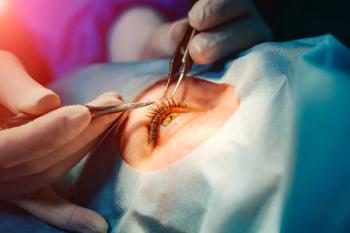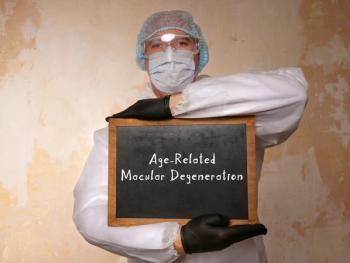
According to a news release from Bausch + Lomb and biomedical laser company Modulight announced that the FDA has approved the ML6710i photodynamic laser for equivalent use with Visudyne.

According to a news release from Bausch + Lomb and biomedical laser company Modulight announced that the FDA has approved the ML6710i photodynamic laser for equivalent use with Visudyne.

According to a news release, the CDC is urging that clinicians and patients immediately discontinue the use of EzriCare Artificial Tears until the epidemiological investigation and laboratory analyses are complete.

According to the company, the approval allows Eyenuk’s EyeArt AI eye screening system, already approved for detection of diabetic retinopathy, to aid millions of additional patients at risk for vision loss.

According to the company, it is planning an end-of-phase 2 meeting with the FDA to discuss the results.

The PRPH2 and Associated Retinal Diseases Workshop is designed to bring together leading experts from academia and industry, to discuss openly, and in detail, what is known about PRPH2 disease pathology, disease models, clinical characteristics, and therapeutic approaches.

A University of Houston researcher has been awarded a $1.6 million grant to help restore vision loss in patients with the rare disease that causes a progressive loss of vision, prompting retinitis pigmentosa.

A team of researchers have found that STOC tomography enables unprecedented views of eye structure.

The United States Department of Justice originally filed the lawsuit in December 2021 on behalf of an elderly quadriplegic patient, alleging that Tempe, Arizona-based Barnet Dulaney Perkins Eye Center was requiring patients with mobility disabilities to hire third-party medical transport and transfer assistance for outpatient surgical procedures. American Vision Partners was named as a codefendant.

Researchers used obesity as a model to accelerate and exaggerate the stressors experienced by the body throughout life.

As a therapy for vision impairment resulting from inherited retinal degeneration, or IRD, the mRNA would instruct photoreceptor cells – faulty because of a genetic mutation – to manufacture the proteins needed for sight.

Researchers discovered that all patients had similar single surgery success rates but that minority patients had significantly worse vision outcomes and were more likely to have multiple retinal breaks.

Investigators coaxed human skin cells reprogrammed to act as stem cells to develop into layers of several types of retinal cells that sense light and ultimately transmit what we see to the brain.

To advance the company’s ability to anticipate on increasing patients’ needs and to pursue long-term growth plans in both fields of expertise, the company decided to spin out its retina division.

FT-001 is administered by a one-time injection into the subretinal space of the eye that delivers a functional copy of the human RPE65 gene to the nuclei of the patient’s retinal cells.

The investment supports the clinical development of two novel programs, both with the aim of being protective against vision loss.

The companies noted that the molecules selected are potent small molecules that work against well-validated therapeutic targets in retinal disease management, and that are designed to enable extended durability in the suprachoroidal space.


According to University of Michigan researchers, blinding eye diseases like macular degeneration, diabetic retinopathy, and glaucoma are accompanied by the death of neurons in the retina that leads to blindness.

According to a research team from the National Eye Institute, part of the National Institutes of Health, the technique provides model for studying genesis of age-related macular degeneration and other eye diseases.

As 2022 draws to a close, it has proven to be a year of interesting developments in retina, and the top headlines of the year bear this out.

In a news release, Opus said it will advance preclinical development programs for BEST1– and RHO-related retinal diseases. The deal expands the company’s addressable patient population for its novel treatments for rare inherited retinal diseases.

The research team, led by Jayantha Gunaratne, PhD, senior principal investigator at IMCB, conducted a comprehensive analysis of the eye fluid samples from a well-defined cohort of proliferative DR patients against the control cohort to deduce impaired mechanistic aspects within the eye.

Korean biotech company MDimune Inc. and scientists from the Clear Vision Research Lab at The Australian National University hope to turn recent research milestones into potential treatments for AMD.

Derek Hodkey, president and CEO of Orbis International, discusses key achievements for the company and its Flying Eye Hospital in 2022 and offers his outlook for 2023.

The National Institute on Aging of the National Institutes of Health (NIH) is expanding the effort to understand that connection with a $10.3 million grant.

Steven J. Fliesler, PhD, has been named the 2022 recipient of the Retina Research Foundation’s (RRF) Paul Kayser International Award in Retina Research presented by the International Society for Eye Research (ISER).

The submission follows the U.S. FDA acceptance of the ONS-5010 BLA for wet AMD, with a PDUFA date of August 29, 2023.

According to University of Michigan investigators, the findings could help inform treatments for blindness in humans.

Lawmakers on Tuesday unveiled the $1.7 trillion proposed spending package needed to avert a government shutdown by Friday if both chambers can pass the measure this week.

Company confirms target read-out around the end of 2023 and regulatory submission in Europe in H1 2024. The data will also play an important supporting role in U.S. regulatory submission.